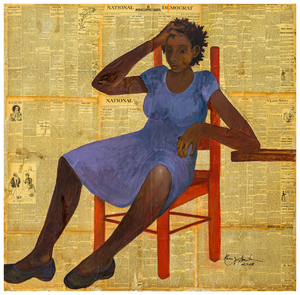Melvin Smith and Rose Smith's 'Journey Of A Lost Tribe' Online Exhibition is on View Today
Fort Gansevoort's first project with the Smiths will be an online exhibition opening October 13, 2022.

Adam Shopkorn, founder of Fort Gansevoort, has announced the gallery's representation of Minnesota-based artists Melvin Smith and Rose Smith.
Fort Gansevoort's first project with the Smiths will be an online exhibition opening October 13, 2022. For the presentation, titled Journey of a Lost Tribe, the Smiths will be in conversation with Amanda Hunt, Head of Public Engagement, Learning, and Impact at the Walker Art Center, Minneapolis.
In 2019, the husband-and-wife artists were the subject of Rose and Melvin Smith: Remembering Rondo, a survey at the Weisman Art Museum at the University of Minnesota, Minneapolis, MN. Consisting of over ninety works spanning a range of mediums, the exhibition found the Smiths memorializing the historic Rondo neighborhood and its rich cultural legacy: With the construction of Interstate-94 between 1956 and 1968, the Smiths witnessed first-hand the destruction of their community as its residents and businesses were displaced by a 'modernizing' infrastructure project.
As a couple, the Smiths have cultivated their artistic careers side-by-side, working in dramatically different styles and mediums. Together, they have traveled to urban epicenters of Black art and culture in search of creative exchange and dispersed communities that they collectively refer to as a "lost tribe." The time they have spent in Harlem in New York City, on the South Side of Chicago, and in New Orleans, has greatly influenced their individual styles and techniques. Filtered through their dual lenses of observation and memory, the Smiths' works in Fort Gansevoort's online exhibition Journey of a Lost Tribe depict urban scenes and portraits of Black life and cultural production across America.
In Rose Smith's mixed media painting The Toil of being a Black Woman (2022), a solitary female figure sits in a chair against the backdrop of newsprint. Her body language and downcast eyes convey fatigue and dejection. This contemplative portrait explores the subject's inner life while also alluding to a sense of collective identity informed by obstacles that many Black women have endured throughout history. The solidity of the sitter's painted form exerts dynamic contrast against the printed text and flatness of the yellowing paper behind her. The vintage newspaper sheets-dating from 1891-inflect this painting with an archival spirit. With the inclusion of pages of a Jim Crow era publication, Rose's work simultaneously reaches into the past while wrestling with the notion of "progress" in the present day.
Painted in the aftermath of hurricane Katrina during a visit to New Orleans, Rose's elegiac Tremé (2007) pays homage to the inhabitants of this historic neighborhood. Awash in violet hues, Tremé typifies the poetic and pointed deployment of color at the core of Rose's painting practice. With sumptuous painterly strokes, she creates in this work an illusion of light emanating from deep purple shadows. The chromatic variation imparts a lyrical, almost sonorous quality-an intentional reference to the rich musical legacy that originated in Tremé's Congo Square. Although no musical instruments are present in the composition, the influence of Louis Armstrong and his soulful jazz ballads imbues the scene with the vibration of New Orleans' musical heritage.
In contrast, Melvin Smith's work Katrina (2008) presents a more direct view of New Orleans in the wake of the Katrina's destruction. Using fragments of found material, Melvin embraces collage as both aesthetic technique and conceptual conceit, reconstructing the damaged city from memory. In this work, a solitary figure stands in front of an open portal, in an image that suggests the feelings of isolation, displacement and loss experienced by so many New Orleans natives in the wake of the hurricane. Melvin's choice of materials inflects his composition with additional narrative specificity. A piece of metal hardware obscures the figure's face, rendering her an anonymous and symbolic presence. Floating in floodwaters in the work's foreground, an image of a wooden shipping crate bearing the words "handle with care" offers pointed critique.
In his eight-foot-long relief sculpture titled Caught Between the Moon and New York City (1996), Melvin recreates the night skyline of the metropolis in wood and paint, capturing the vibrant energy in a dynamic juxtaposition of colors and forms. With its title drawn from the lyrics of Christopher Cross' theme song for the 1981 film Arthur, Melvin implies here that his own identity-as both an artist and a Black man- exists in a vulnerable realm somewhere between the heavenly and earthly, the ideal and the all too real. Having lived in a community devastated by eminent domain, the artist profoundly recognizes the fragility of his own story and artistic legacy and the importance of preservation.
In her conversation with the Smiths for this exhibition, Amanda Hunt remarked on the significance of the couple's artistic process: "That's how we change history. Somebody tells the story, keeps telling the story until the history is corrected."
Though their styles are decisively independent, as partners and creators, Melvin and Rose Smith are united in their artistic vision. As passionate storytellers, they create work that collectively functions as a living archive of the various communities in which they have lived while demonstrating the power of place to inspire.

Videos

